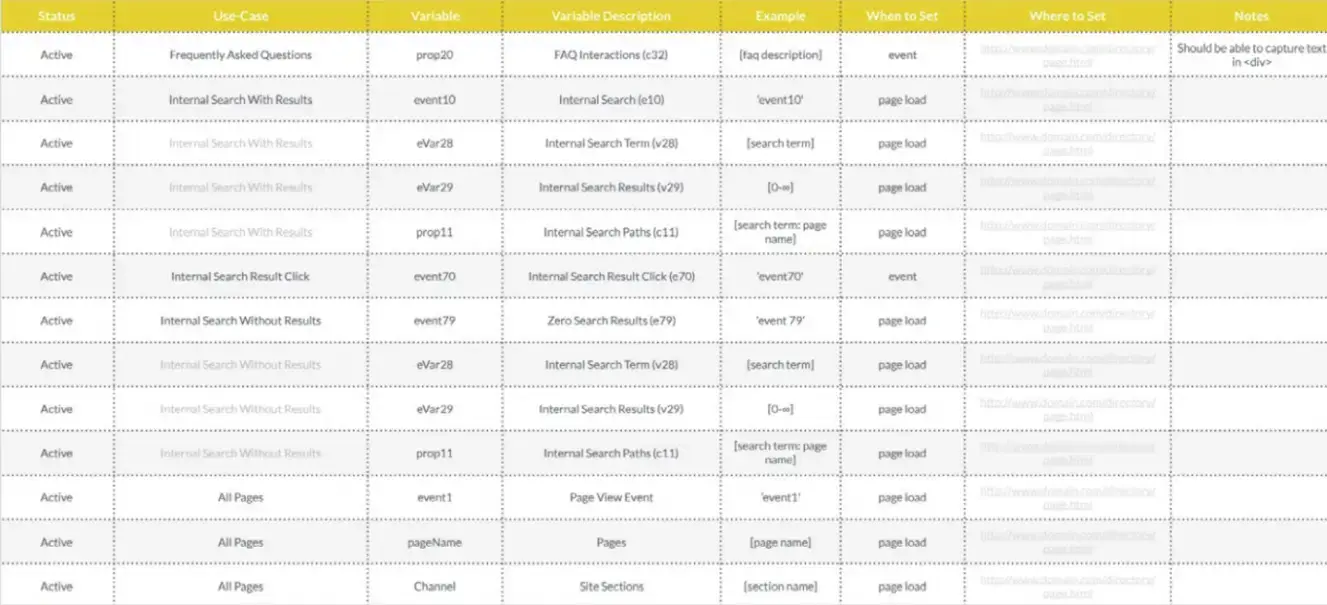
Building a website tagging strategy and associated tagging plan are important steps to ensuring the success of any analytics or digital marketing program.
Interestingly, one of the biggest failures in building a website tagging strategy is simply not building one. So before you start installing tags on your site with little to no thought, first walk through the following steps to make sure you have all your ducks in a row.
We approach the topic as if we were building a new website, but best practices are best practices regardless. You can apply these same principles no matter how old your website.
Let’s get started.
1. Determine business requirements
Ask yourself: “Why does my website exist? What am I trying to accomplish?” Answering these questions will give direction to your website tagging strategy. If you understand the “why” behind your website, you will be able to more easily identify which tags (vendors) you need to install.
Identify the why
If you’re not quite sure why your website exists, consider this statement: Most websites exist to sell more stuff. Even if your website is not an eCommerce site, you are likely trying to improve revenues by offering motivation to your customer base to engage with your products or services. For example:
- Financial services websites offer information/services online so that you’ll do more business with them.
- Automobile companies try to redirect you to one of their dealers so you can buy their cars.
- Restaurant websites entice you to try their food.
- Media websites either sell their content or sell space to advertisers—or both. In either case they are selling something.
No matter what your content is, you’re really trying to sell merchandise, services, or ideas.
Learn more about how knowing your “why” affects your web analytics strategy.
Write your business requirements
In order for you to sell, to achieve your “why,” what does your website need to accomplish? Find the answer to this question, and you have your business requirements.
Here are some examples of business requirements in plain language:
- I need to monitor user behavior on lead-gen landing pages so I can optimize conversions
- I need to test different variations of a web page to determine which performs best
- I need to capture campaign variables to establish ROI on campaigns
Once you have your business requirements listed out, you’ll have an idea of the technologies you need:
- Web analytics
- A/B testing
- Attribution
Business Requirements for Web Analytics Tools
For web analytics tools, you will also want to identify your primary metrics before installing the analytics tag. You can measure just about anything, but you don’t need to measure everything. To keep your analytics aligned to business objectives, determine your primary metrics before installing the tool.
2. Choose vendors
You may already have vendors in mind when writing out your business requirements. For each candidate, go through the following vendor approval checklist:
- Does the vendor meet our business requirements?
- Does the cost of the vendor fit within our budget?
- Does the vendor comply with data privacy regulations?
- Does the vendor provide training?
If after going through these questions, you still feel good about the vendor, then you should be good to move forward.
3. Document your tags and variables
Once you have your business requirements and you have selected vendors, you can start building out documentation about each tag and the variables within those tags. (For a quick refresher about tags, check out this post sharing all you need to know about web tags.)
Tag documentation is known by many names, including a tagging plan, a solution design reference (SDR), a tech spec, a variable strategy, etc. To simplify, let’s call it a tagging plan.
Your tagging plan is the technical counterpart for your business requirements. To draw an analogy, your tagging plan is comparable to a building’s blueprint, giving technical descriptions of how to build and wire the structure.
Here is a small portion of an example tagging plan, specifically for Adobe Analytics:

Avoid letting your tagging plan become a dusty document buried in someone’s hard drive. Bring this document online, keep it alive and make it accessible to anyone deploying/testing tags or analyzing data. Every time your website or analytics changes, the tagging plan needs to be updated.
4. Deploy your tags
You have your blueprint—are you ready to build? There are a few ways you can deploy your tags. We’ll talk about each:
a. Manually on each page
If you have a relatively small website where each page has unique tagging needs, then you could potentially install each tag on each page, though this approach is not advisable.
b. Through your content management system
Another alternative is to install tags in accordance with the templates of your content management system (CMS). Within your CMS, you should be able to group pages by similar tagging profiles and install the required tags in the heads of those templates. For example, all the product pages on an eCommerce site probably use the same analytics variables, so they can all include the same tag configuration. While this approach is better than the previous one, the following approach is best and is no more work than the first two.
c. Through a tag management system
Tag management systems (TMSs) allow you to deploy tags through a container code which you install on every page of your site. So instead of installing tags onto each page, you configure your TMS to fire specific tags based on predefined rules. To use another eCommerce example, you might have specific tags fire whenever a /product/ page loads.
Testing and Quality Assurance
If you have a large site and tags with a lot of custom variables, you will want to test those tags before pushing them onto your live site. Your ability to do so will depend on the availability of dev resources and the maturity of your tagging plan. Best practice is to bring your tagging plan rules online so you can more easily automate testing and validation.
5. Maintain your website tagging strategy
A common way tagging strategies fall apart is when they’re not properly maintained.
Websites have a lot of moving parts. They change constantly. As a result, there are myriad reasons why tags can stop working, such as:
- Errors in page code that prevent tags from firing correctly or collecting information
- Conflicting code from other Javascript functions
- Website structure updates that make data inaccessible to your tags
- Misconfigured TMS rules that cause tags not to fire
- Slow-loading elements on a page that stop a tag from collecting data
If you don’t frequently check your tags to make sure they’re working properly, something could go wrong and you simply won’t know about it. To avoid broken tags, you can adopt tag governance into your website tagging strategy.
Tag governance is comprised of tag validation, tag auditing, and tag monitoring.
- Tag auditing. Tag audits scour your website and make sure your tags are where you expect them to be. In combination with a tagging plan, tag auditing tools can greatly improve the quality of the data passed through tags.
- Tag monitoring. Like tag auditing, tag monitoring scans your website to detect potential tagging errors. But instead of scanning a large batch of pages, tag monitoring scans sequences and batches of pages on your live site to ensure tags are constantly up and running.
- Tag validation. Tag validation is a form of release validation. When you’re getting ready to release an update to your website, tag validation tools allow you to prepare tests to be run before and after release.
Essentially, tag governance brings your website tagging strategy full circle, making sure your chosen vendors function properly and meet your business requirements. If you have a large website, performing these audits manually may be unrealistic, so you might consider using an automated governance solution like ObservePoint.
See ObservePoint in action in the below 9-minute demo.
More Resources for Your Website Tagging Strategy
A website tagging strategy is the most effective way to ensure your website tags work properly under all conditions. The next step is to apply these top 5 website tagging best practices.





